North America Lithium-ion Battery for Electric Vehicle Market Size
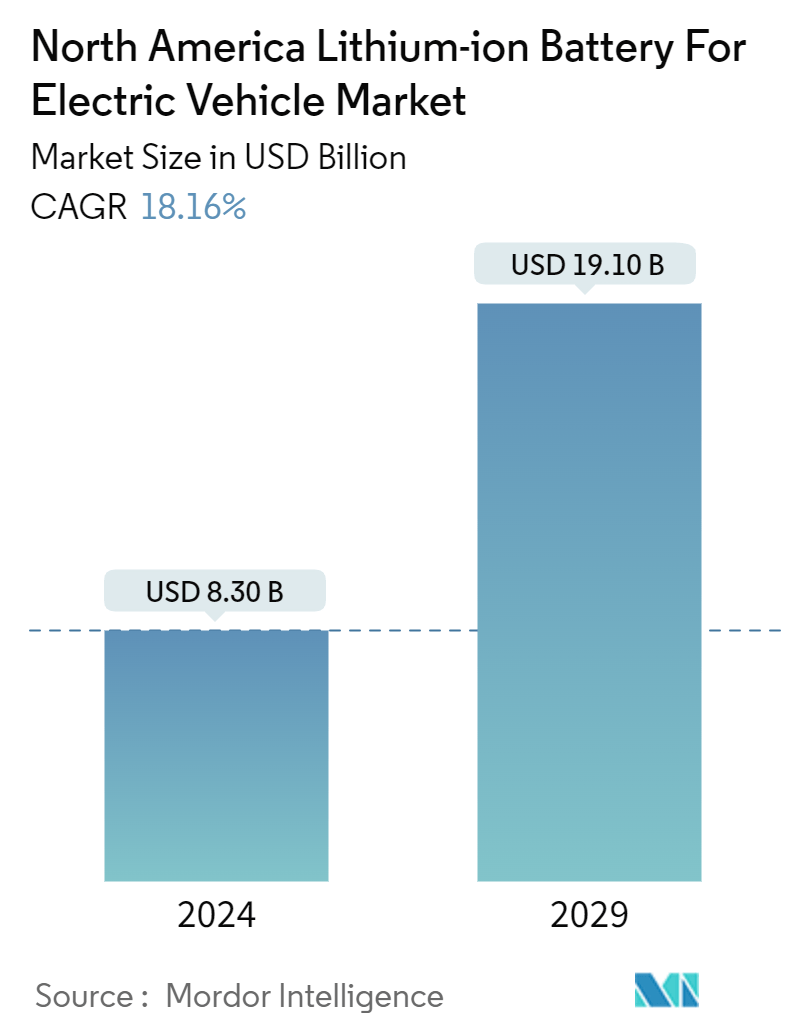
| Study Period | 2019 - 2029 |
| Base Year For Estimation | 2023 |
| Market Size (2024) | USD 8.30 Billion |
| Market Size (2029) | USD 19.10 Billion |
| CAGR (2024 - 2029) | 18.16 % |
| Market Concentration | Medium |
Major Players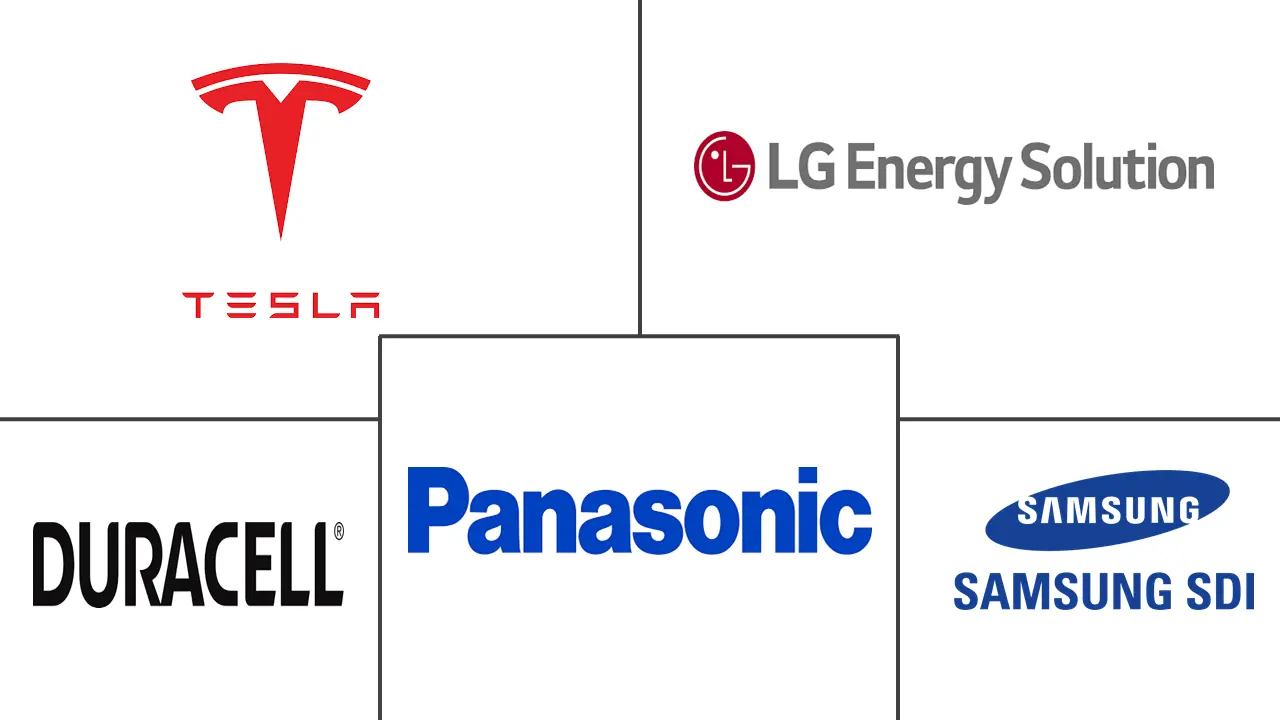
*Disclaimer: Major Players sorted in no particular order |
North America Lithium-ion Battery for Electric Vehicle Market Analysis
The North America Lithium-ion Battery For Electric Vehicle Market size is estimated at USD 8.30 billion in 2024, and is expected to reach USD 19.10 billion by 2029, growing at a CAGR of 18.16% during the forecast period (2024-2029).
- Over the long term, declining lithium-ion battery prices and the growing usage of electric vehicles in the United States, Canada, and Mexico are expected to drive the growth of the market.
- On the other hand, the emerging alternative battery technologies and the demand-supply mismatch of raw materials are likely to affect the market's growth during the forecast period.
- Nevertheless, the adoption of solid-state lithium-ion batteries for electric vehicles in North American countries is anticipated to provide opportunities for the market’s growth.
- The United States is expected to dominate the market, with favorable government policies and increasing utilization of electric vehicles.
North America Lithium-ion Battery for Electric Vehicle Market Trends
Battery Electric Vehicle (BEV) Segment Is Expected to Dominate the Market
- Battery electric vehicles (BEVs) are also commonly referred to as electric vehicles with an electric motor. BEVs are fully electric vehicles that typically do not include an internal combustion engine (ICE), fuel tank, or exhaust pipe and rely on electricity for propulsion. The vehicle's energy comes from the battery pack recharged from the grid. BEVs are zero-emission vehicles, and they do not generate harmful tailpipe emissions or air pollution hazards caused by traditional gasoline-powered vehicles.
- The primary factors like increasing demand for automotive vehicles across North America, growing innovation and advanced technology, rising consumer awareness about the use of fuel-efficient cars, and growing awareness to reduce greenhouse gasses and emissions are driving the demand for battery electric vehicles (BEV) across the region.
- BEVs are electric vehicles that do not have an Internal Combustion Engine (ICE), fuel tank, or exhaust pipe. They rely solely on stored electricity for propulsion. The vehicle’s energy comes from the battery, which is recharged from the grid. BEVs are zero-emissions vehicles that do not generate any harmful tailpipe emissions or air pollution hazards that traditional gasoline-powered vehicles do.
- According to the International Energy Agency (IEA), the sales of US battery electric vehicle (BEV) cars stood at around 1.1 million units in 2023, followed by Canada's sales of about 0.13 million units. As the sales of BEVs continue to rise, the demand for EV batteries, such as lithium-ion batteries, has become increasingly vital.
- In the United States, around 1.6 million electric vehicles were sold in 2023, a 60% increase from the 1 million sold nationwide in 2022. The United States accounted for 10% of all new EV registrations worldwide in 2023. Also, in the United States, the potential impact of the Inflation Reduction Act (IRA) and the implementation of California's Advanced Clean Cars II rule by multiple states could lead to a significant market share of 50% for electric cars by 2030, aligning with the nation’s target. Moreover, the anticipated implementation of the recently proposed emissions standards introduced by the United States Environmental Protection Agency is expected to contribute even more to this growing market share for electric vehicles.
- Moreover, private sector investments will most likely drive the Canadian electric vehicle battery market. For instance, in April 2023, Volkswagen and the Government of Canada declared a joint investment of more than USD 14.8 billion to build a battery manufacturing unit or gigafactory in Ontario. Moreover, the Government of Canada announced an investment of approximately USD 10.05 billion in manufacturing tax credits through 2032 to match USD 35 per kilowatt hour in production subsidies provided by the United States Inflation Reduction Act (IRA).
- Therefore, due to the factors mentioned above, the BEV segment is likely to dominate the North American lithium-ion battery for electric vehicle (EV) market over the forecast period.
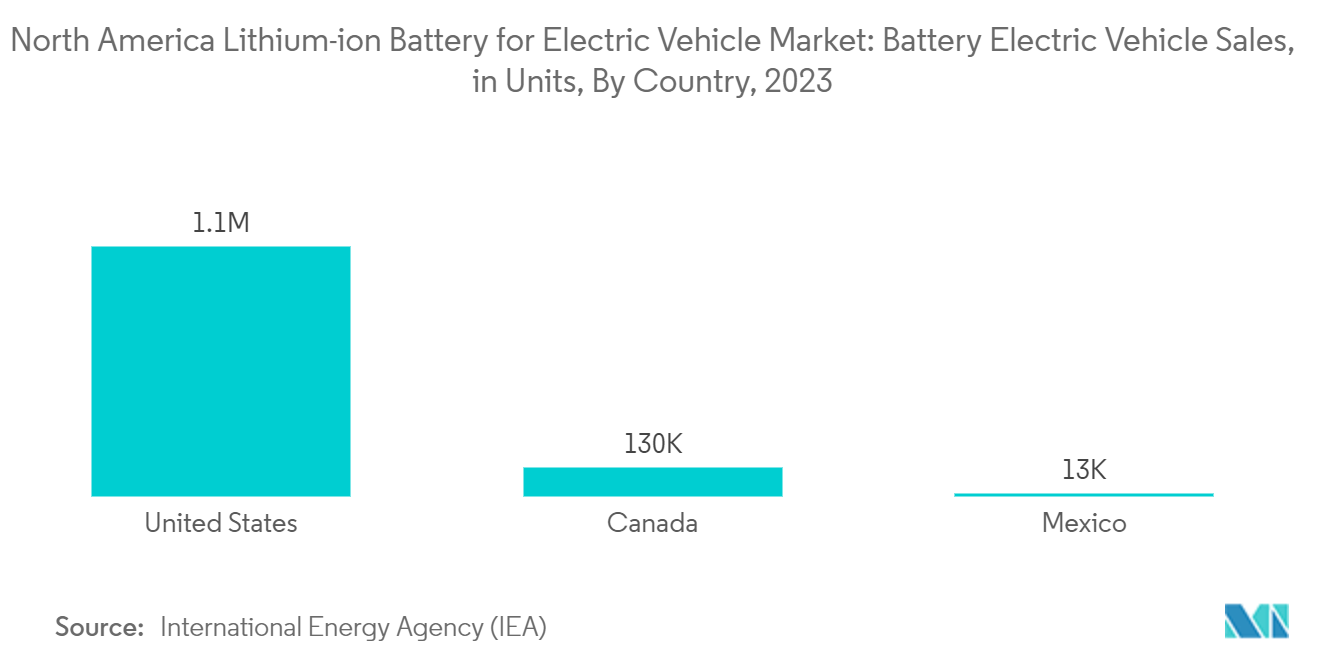
United States to Dominate the Market
- Electric vehicles (EVs) have become popular owing to their eco-friendly nature and cost-effective benefits. Factors like rising fuel costs, increasing awareness about greenhouse gas emissions, and exclusive smart features have been boosting the demand for electric vehicles in the United States. This is expected to drive the electric vehicle battery market in the United States.
- According to the International Energy Agency (IEA), the US battery electric vehicle (BEV) cars sales stood at around 1.1 million units (BEV cars) in 2023, an increase of over 37.5% from around 0.8 million units in 2022. As the sales of BEVs continue to rise, the demand for EV batteries, such as lithium-ion batteries, has become increasingly vital.
- According to the Office of Energy Efficiency and Renewable Energy, in January 2023, the government was considering the planned electric vehicle battery plants in North America. The region is expected to witness a ramping up of manufacturing capacity from 55 gigawatts per year (GWh/year) in 2021 to 1000 GWh/year by 2030. Also, most of the projects in the pipeline are anticipated to initiate production between the years 2025 to 2030. This indicates a robust development of the electric vehicle battery market in the next couple of years.
- Moreover, in February 2023, Ascend Elements, a US-based battery recycling and engineered materials company, announced a basic agreement with Honda Motor Co. Ltd to collaborate on stable procurement of recycled lithium-ion battery materials for Honda electric vehicles in North America, which is expected to reduce the carbon footprint of electric vehicles.
- Owing to the above points, the increasing usage of electric vehicles in the United States is expected to dominate the North American lithium-ion battery for electric vehicle market during the forecast period.
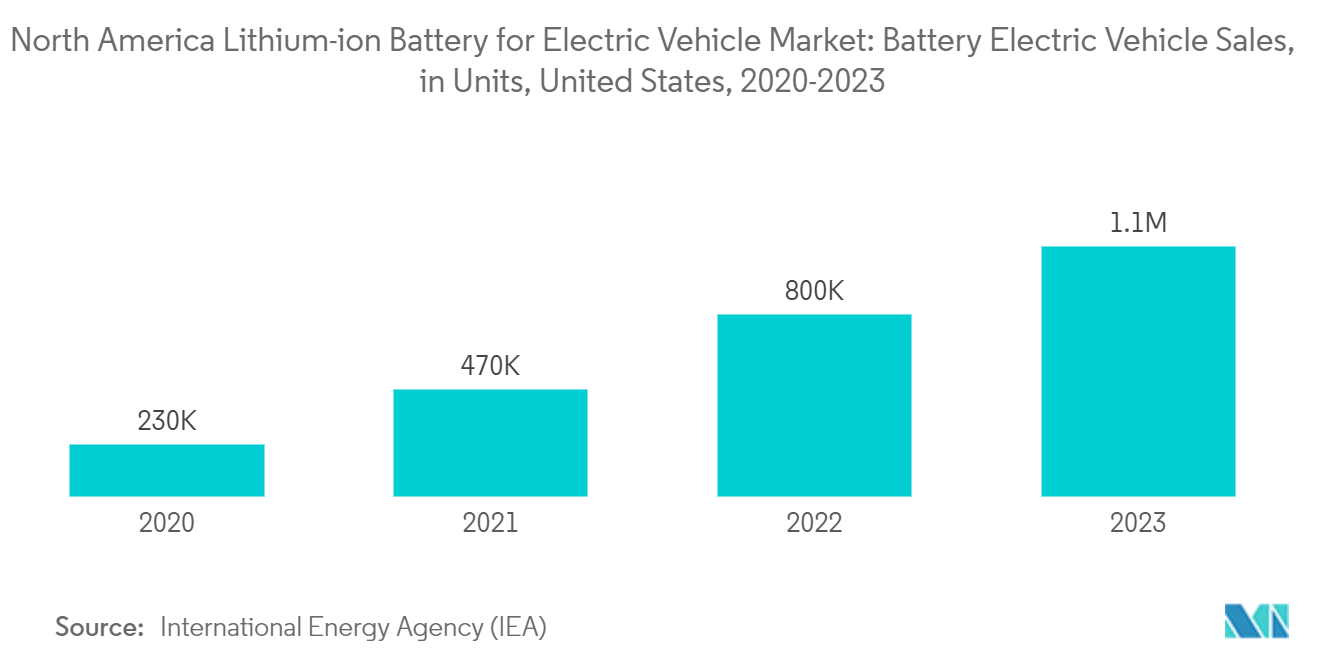
North America Lithium-ion Battery for Electric Vehicle Industry Overview
The North American lithium-ion battery for electric vehicle market is semi-fragmented. Key market players include Tesla Inc., LG Energy Solution Ltd, Panasonic Corporation, Duracell Inc., and Samsung SDI Co. Ltd.
North America Lithium-ion Battery for Electric Vehicle Market Leaders
-
Tesla Inc.
-
LG Energy Solution Ltd
-
Panasonic Corporation
-
Duracell Inc.
-
Samsung SDI Co. Ltd
*Disclaimer: Major Players sorted in no particular order
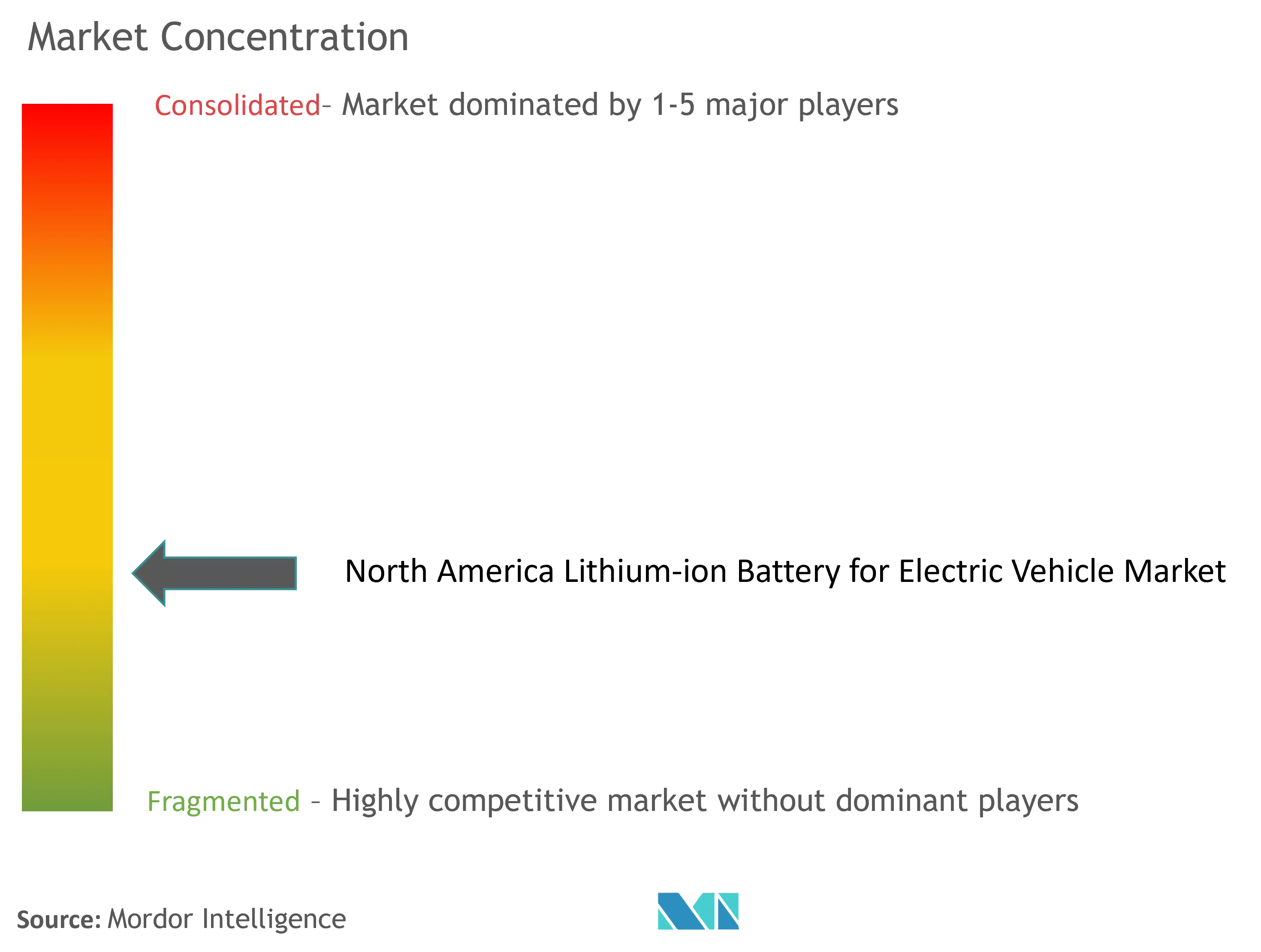
North America Lithium-ion Battery for Electric Vehicle Market News
- October 2023: LG Energy Solution, a leading global manufacturer of lithium-ion batteries for electric vehicles, inked an agreement with Toyota Motor North America Inc. to supply lithium-ion battery modules to be used in Toyota battery electric vehicles (BEVs), which will then be assembled in the United States. As per the agreement, starting in 2025, LG Energy will supply automotive battery modules at an annual capacity of 20 GWh.
- January 2023: Contemporary Amperex Technology Co. Limited (CATL) and UL Solutions announced an agreement for strategic cooperation to aid in enhancing the safe deployment and utilization of battery energy storage systems (BESS) and electric vehicle (EV) batteries. The companies will also cooperate and explore lithium-ion battery safety and provide perspective into developing BESS and EV battery standards.
North America Lithium-ion Battery for Electric Vehicle Market Report - Table of Contents
1. INTRODUCTION
- 1.1 Scope of the Study
- 1.2 Market Definition
- 1.3 Study Assumptions
2. RESEARCH METHODOLOGY
3. EXECUTIVE SUMMARY
4. MARKET OVERVIEW
- 4.1 Introduction
- 4.2 Market Size and Demand Forecast in USD, till 2029
- 4.3 Recent Trends and Developments
- 4.4 Government Policies and Regulations
-
4.5 Market Dynamics
- 4.5.1 Drivers
- 4.5.1.1 Declining Lithium-Ion battery Prices
- 4.5.1.2 Growing Adoption of Electric Vehicles
- 4.5.2 Restraints
- 4.5.2.1 Demand-Supply Mismatch of Raw Materials
- 4.6 Supply Chain Analysis
-
4.7 Porter's Five Forces Analysis
- 4.7.1 Bargaining Power of Suppliers
- 4.7.2 Bargaining Power of Consumers
- 4.7.3 Threat of New Entrants
- 4.7.4 Threat of Substitutes Products and Services
- 4.7.5 Intensity of Competitive Rivalry
5. MARKET SEGMENTATION
-
5.1 Vehicle Type
- 5.1.1 Passenger Vehicles
- 5.1.2 Commercial Vehicles
- 5.1.3 Others (Bikes, Scooters, etc.)
-
5.2 Propulsion Type
- 5.2.1 Battery Electric Vehicle (BEV)
- 5.2.2 Plug-In Hybrid Electric Vehicle (PHEV)
- 5.2.3 Hybrid Electric Vehicles (HEV)
-
5.3 Geography
- 5.3.1 United States
- 5.3.2 Canada
- 5.3.3 Rest of North America
6. COMPETITIVE LANDSCAPE
- 6.1 Mergers and Acquisitions, Joint Ventures, Collaborations, and Agreements
- 6.2 Strategies Adopted by Leading Players
-
6.3 Company Profiles
- 6.3.1 BYD Company Ltd
- 6.3.2 Contemporary Amperex Technology Co. Limited
- 6.3.3 EnerSys
- 6.3.4 Duracell Inc.
- 6.3.5 Clarios (Formerly Johnson Controls International PLC)
- 6.3.6 Panasonic Corporation
- 6.3.7 LG Energy Solutions Ltd
- 6.3.8 VARTA AG
- *List Not Exhaustive
- 6.4 List of Other Prominent Companies (Company Name, Headquarter, Relevant Products & Services, Contact Details, etc.)
- 6.5 Market Ranking/Share (%) Analysis
7. MARKET OPPORTUNITIES AND FUTURE TRENDS
- 7.1 Adoption of Solid-State Lithium-Ion Batteries for Electric Vehicles
North America Lithium-ion Battery for Electric Vehicle Industry Segmentation
A lithium-ion battery for electric vehicles (EVs) is a type of rechargeable battery commonly used to power electric cars and other electric transportation. Known for its high energy density, long cycle life, and lightweight design, this battery technology enables efficient storage and delivery of electrical energy. Lithium-ion batteries consist of cells containing an anode, cathode, separator, and electrolyte. These batteries offer a high power-to-weight ratio, excellent energy efficiency, and reduced self-discharge compared to others, which make them a top choice for modern electric vehicles.
The North American lithium-ion battery for electric vehicle market is segmented into vehicle type, propulsion type, and geography. By vehicle type, the market is segmented into passenger vehicles, commercial vehicles, and others (bikes, scooters, etc.). By propulsion type (battery electric vehicle (BEV), hybrid electric vehicles (HEV), and plug-in hybrid electric vehicle (PHEV). The report also covers the market size and forecasts for the lithium-ion battery for the electric vehicle market across major countries. The report offers the market size and forecasts for the revenue for all the above segments.
| Vehicle Type | Passenger Vehicles |
| Commercial Vehicles | |
| Others (Bikes, Scooters, etc.) | |
| Propulsion Type | Battery Electric Vehicle (BEV) |
| Plug-In Hybrid Electric Vehicle (PHEV) | |
| Hybrid Electric Vehicles (HEV) | |
| Geography | United States |
| Canada | |
| Rest of North America |
North America Lithium-ion Battery for Electric Vehicle Market Research FAQs
How big is the North America Lithium-ion Battery For Electric Vehicle Market?
The North America Lithium-ion Battery For Electric Vehicle Market size is expected to reach USD 8.30 billion in 2024 and grow at a CAGR of 18.16% to reach USD 19.10 billion by 2029.
What is the current North America Lithium-ion Battery For Electric Vehicle Market size?
In 2024, the North America Lithium-ion Battery For Electric Vehicle Market size is expected to reach USD 8.30 billion.
Who are the key players in North America Lithium-ion Battery For Electric Vehicle Market?
Tesla Inc., LG Energy Solution Ltd, Panasonic Corporation, Duracell Inc. and Samsung SDI Co. Ltd are the major companies operating in the North America Lithium-ion Battery For Electric Vehicle Market.
What years does this North America Lithium-ion Battery For Electric Vehicle Market cover, and what was the market size in 2023?
In 2023, the North America Lithium-ion Battery For Electric Vehicle Market size was estimated at USD 6.79 billion. The report covers the North America Lithium-ion Battery For Electric Vehicle Market historical market size for years: 2019, 2020, 2021, 2022 and 2023. The report also forecasts the North America Lithium-ion Battery For Electric Vehicle Market size for years: 2024, 2025, 2026, 2027, 2028 and 2029.
North America Lithium-ion Battery for Electric Vehicle Industry Report
Statistics for the 2024 North America Lithium-ion Battery For Electric Vehicle market share, size and revenue growth rate, created by Mordor Intelligence™ Industry Reports. North America Lithium-ion Battery For Electric Vehicle analysis includes a market forecast outlook for 2024 to (2024to2029 and historical overview. Get a sample of this industry analysis as a free report PDF download.



